Abstract
Episome F' ts114 lac+, his+ (F42-400) was transferred from Salmonella typhimurium to Klebsiella pneumoniae. From the progeny, a strain of K. pneumoniae able to retransfer the episome was obtained. The His+ phenotype in this strain is temperature sensitive. Escherichia coli female-specific phages phiII, W31, and T3 were shown to plate on K. pneumoniae. From phiII we obtained two derivatives; phiIIK, which plates only on K. pneumoniae, and phiIIE, which plates only on E. coli. Growth of phages T3 and phiIIK was inhibited by F42-400 in K. pneumoniae. Growth in presence of acridine orange in a defined medium at 40 C resulted in a high level of curing. The frequency of His+ cells after growth in acridine orange at 40 C was 0.001%. An extensive search to detect chromosome mobilization by F42-400 in K. pneumoniae, under different experimental conditions, was negative. We cannot exclude the possibility that the low transfer efficiencies prevented our detection of chromosome mobilization. A search among temperature-resistant, acridine orange-curing-resistant, or galactose-resistant derivatives of the K. pneumoniae donor strain failed to reveal any chromosome transfer. Our failure to detect Hfr's may be a result of: (i) the peculiarity of episome F42-400, (ii) the peculiarity of K. pneumoniae chromosome, or (iii) low transfer efficiency. K. pneumoniae-modified F42-400 and phage 424 were restricted by E. Coli K-12. E. coli K-12-modified episome F42-400 and phage 424 were restricted by K. pneumoniae. E. coli C failed to restrict F42-400 modified with K. pneumoniae specificity. The ability of K. pneumoniae to accept F42-400 is less, by about a factor of 50, than that of E. coli C. As an explanation for the differences in the behavior of E. coli C and K. pneumoniae in ability to receive F42-400 it was suggested that recipient bacteria have specific sites for interaction with the F-pilus tip; these are present in E. Coli C, leading to high transfer efficiency, whereas they may not be present (or if present, are not accessible) in K. pneumoniae, leading to low transfer efficiency.
Full text
PDF
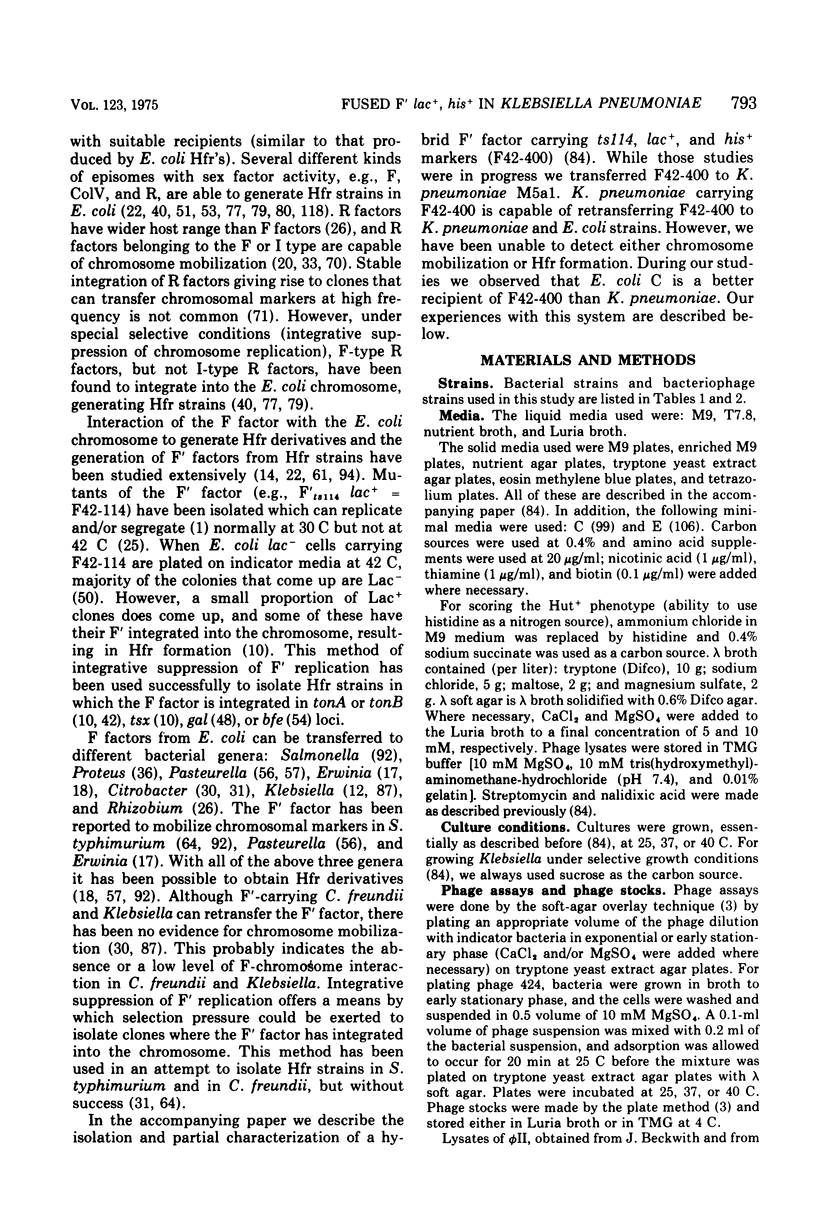
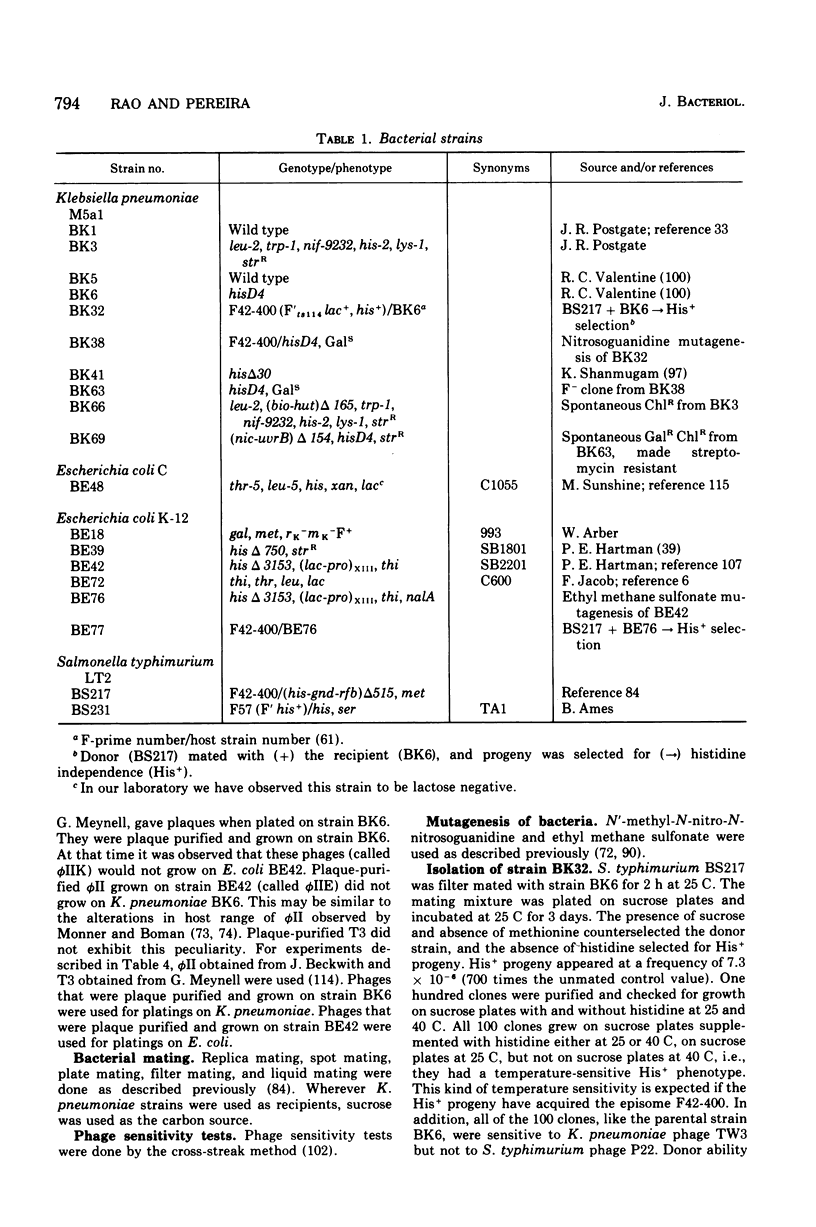
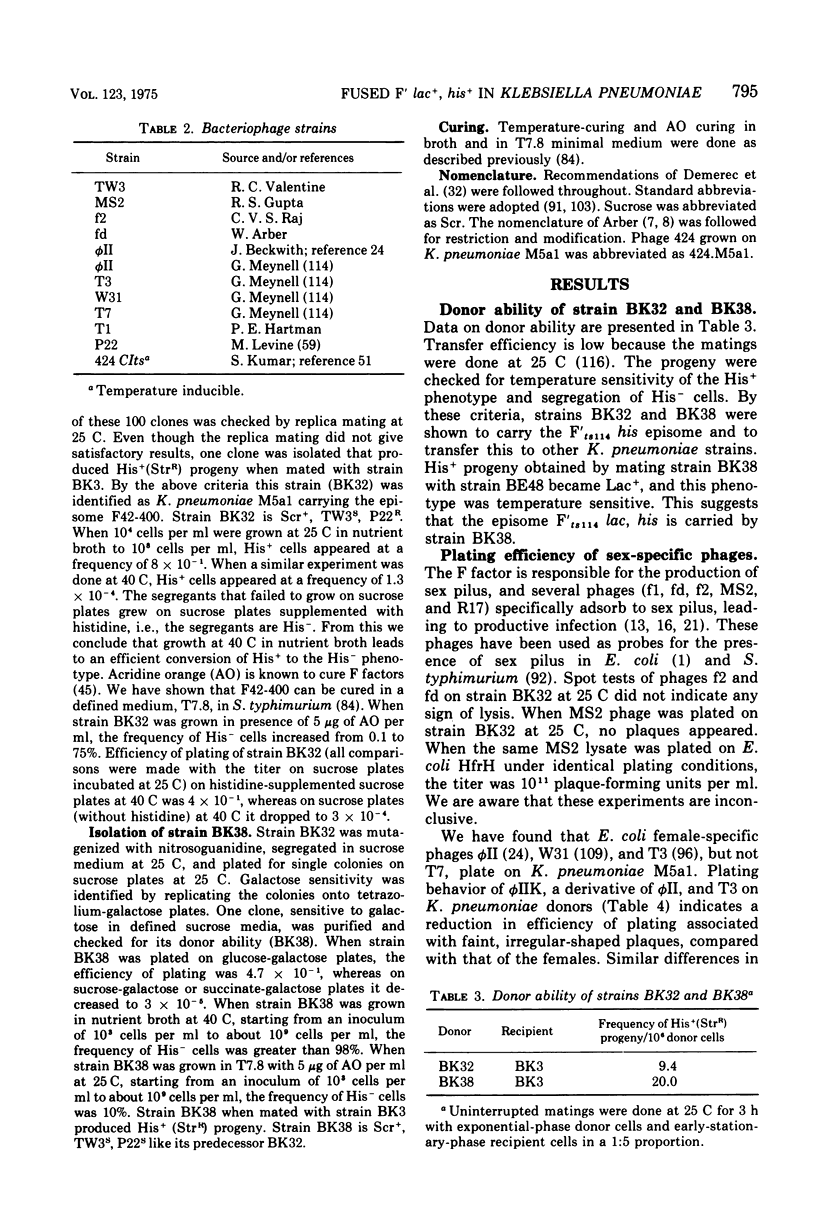
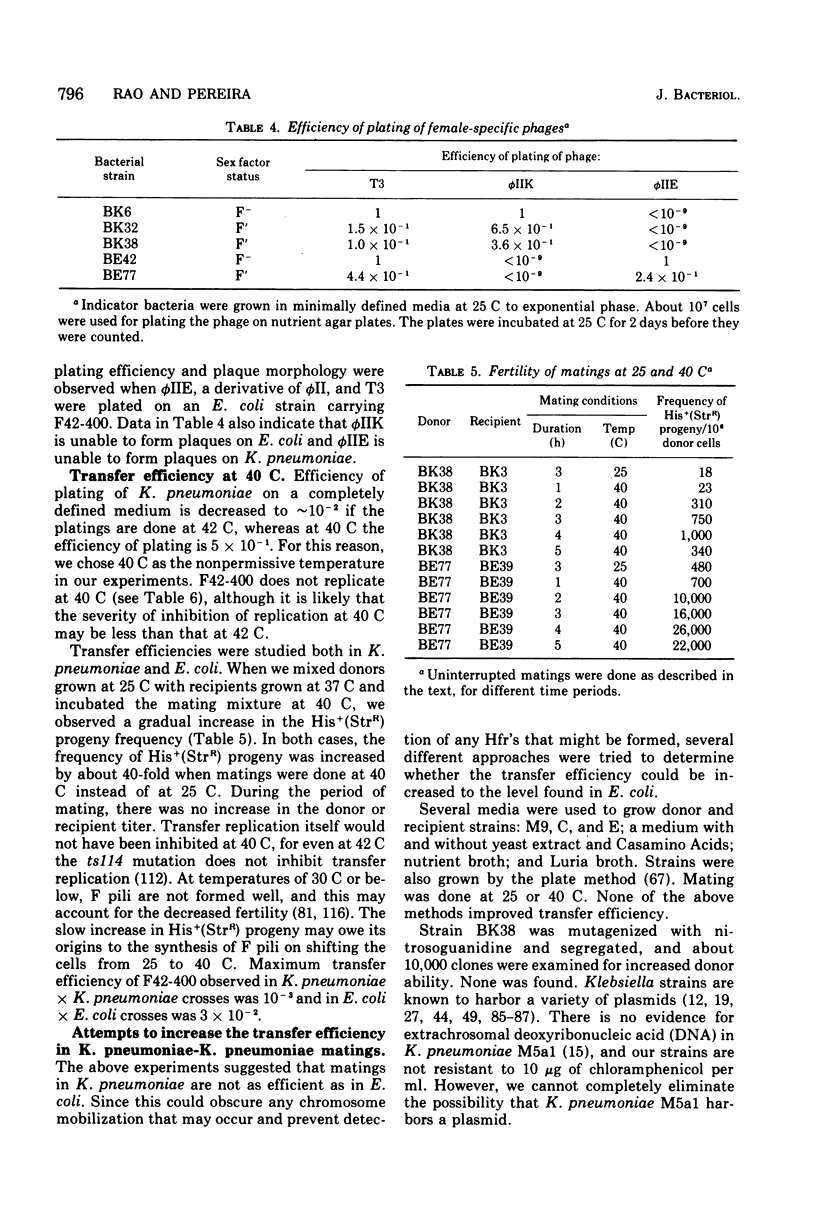
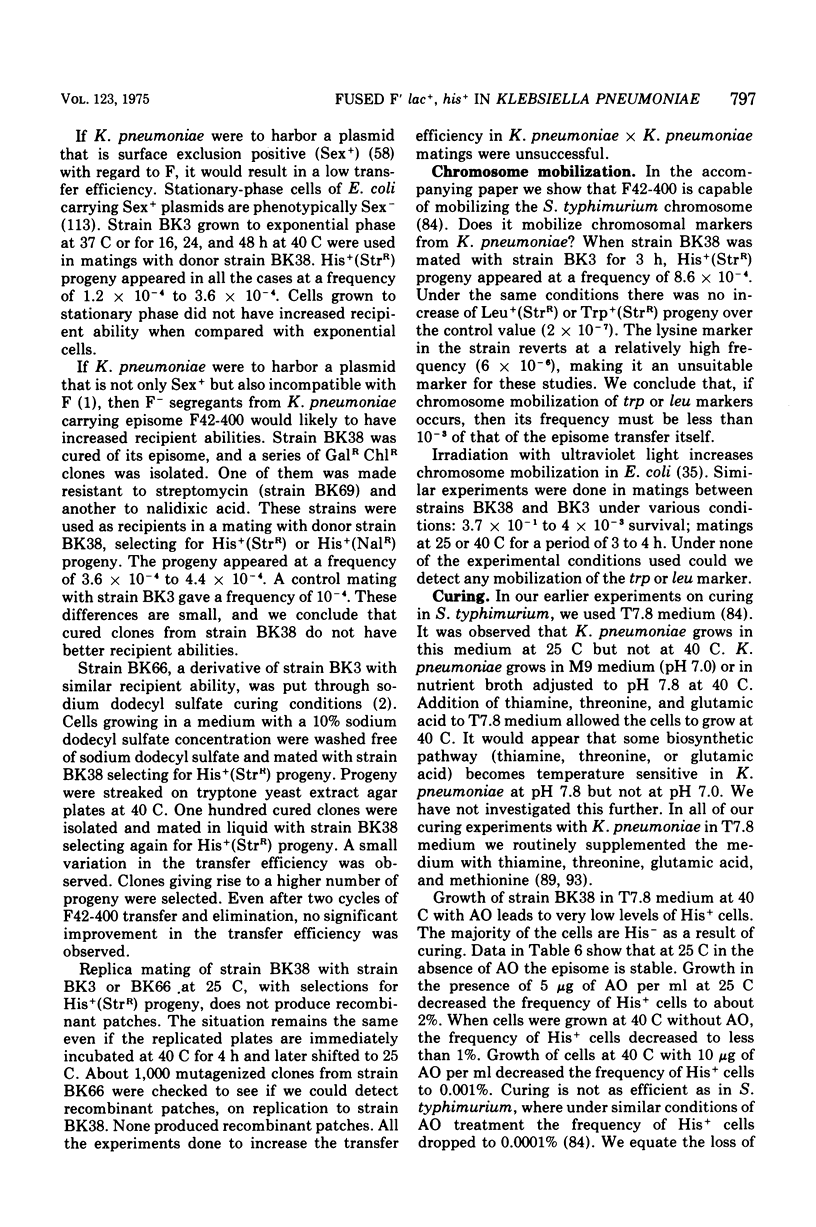
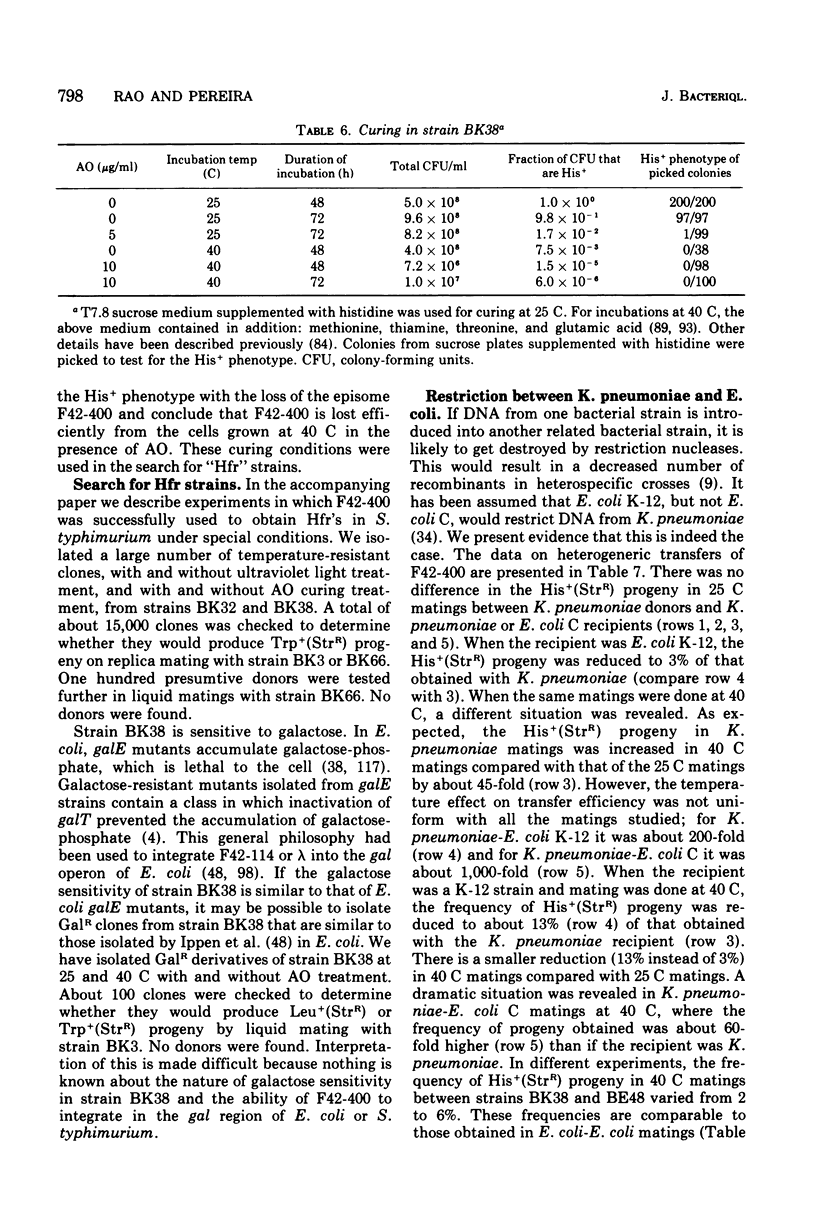
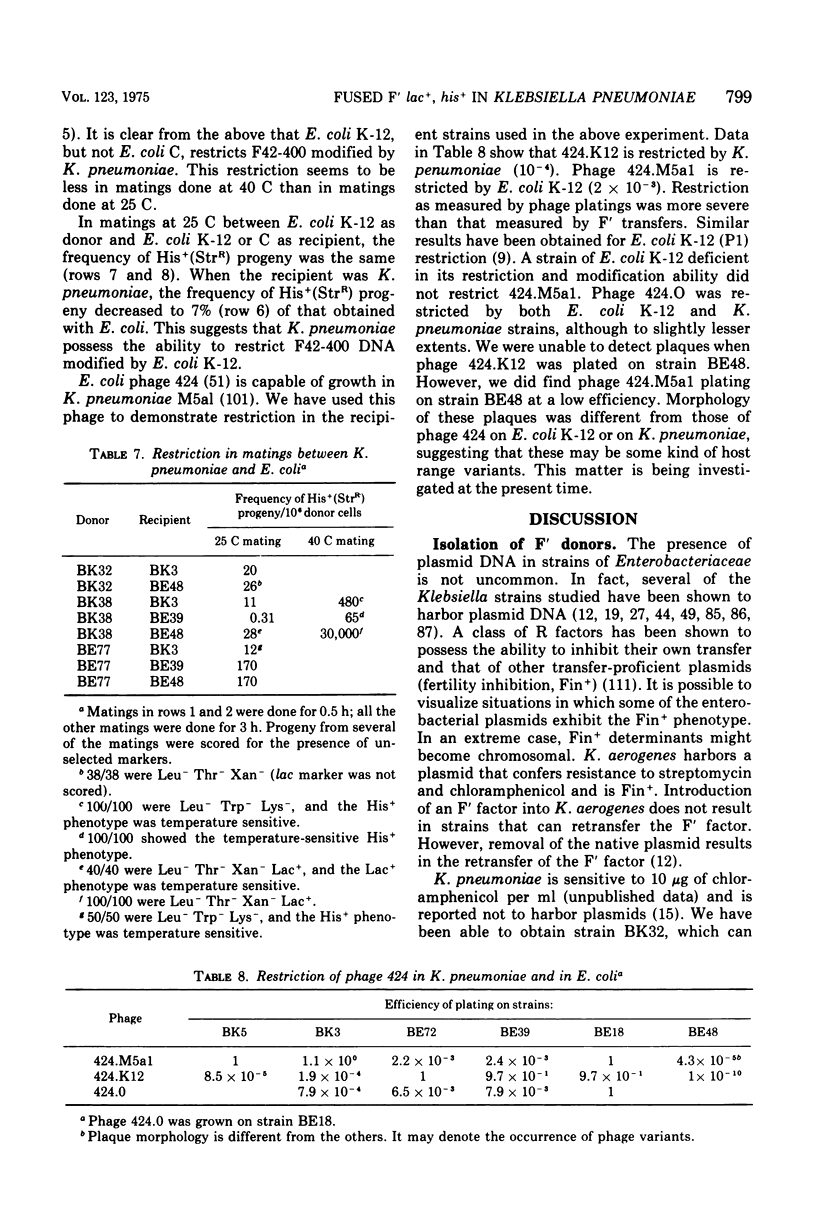
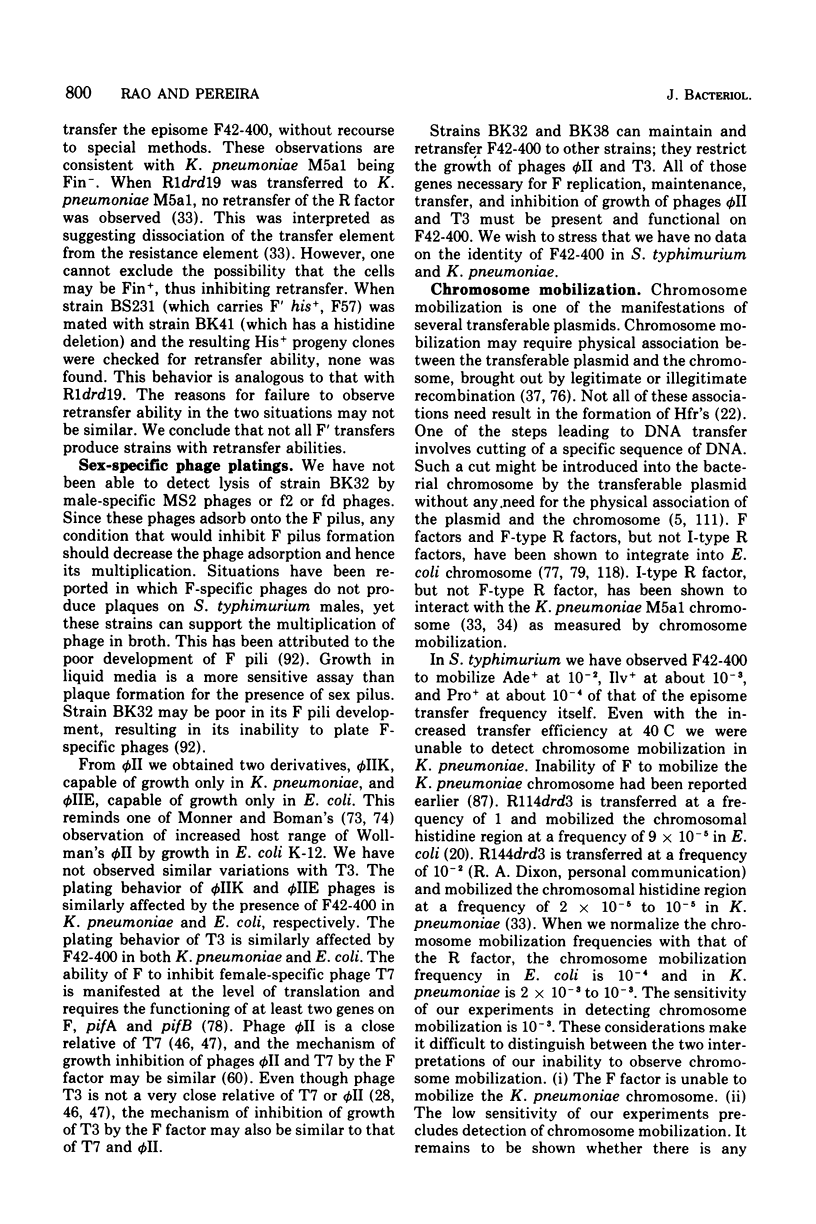
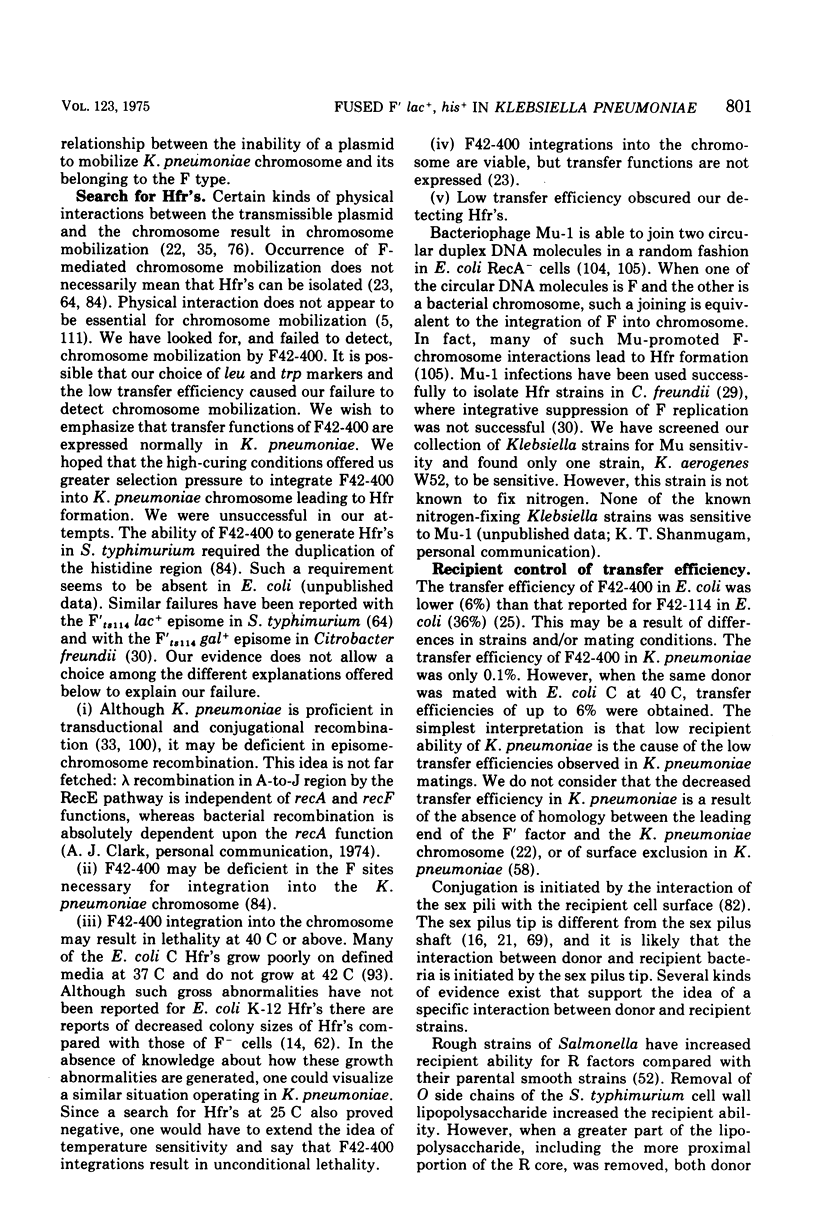
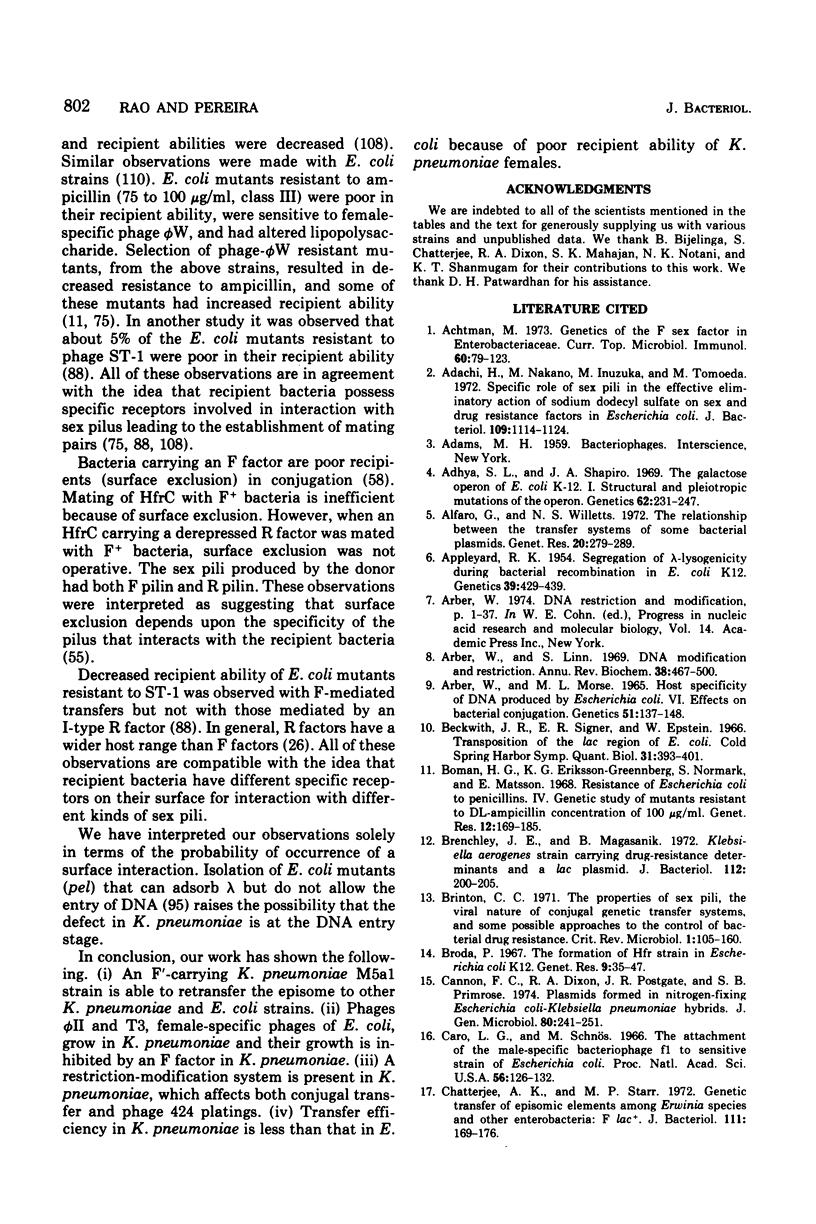
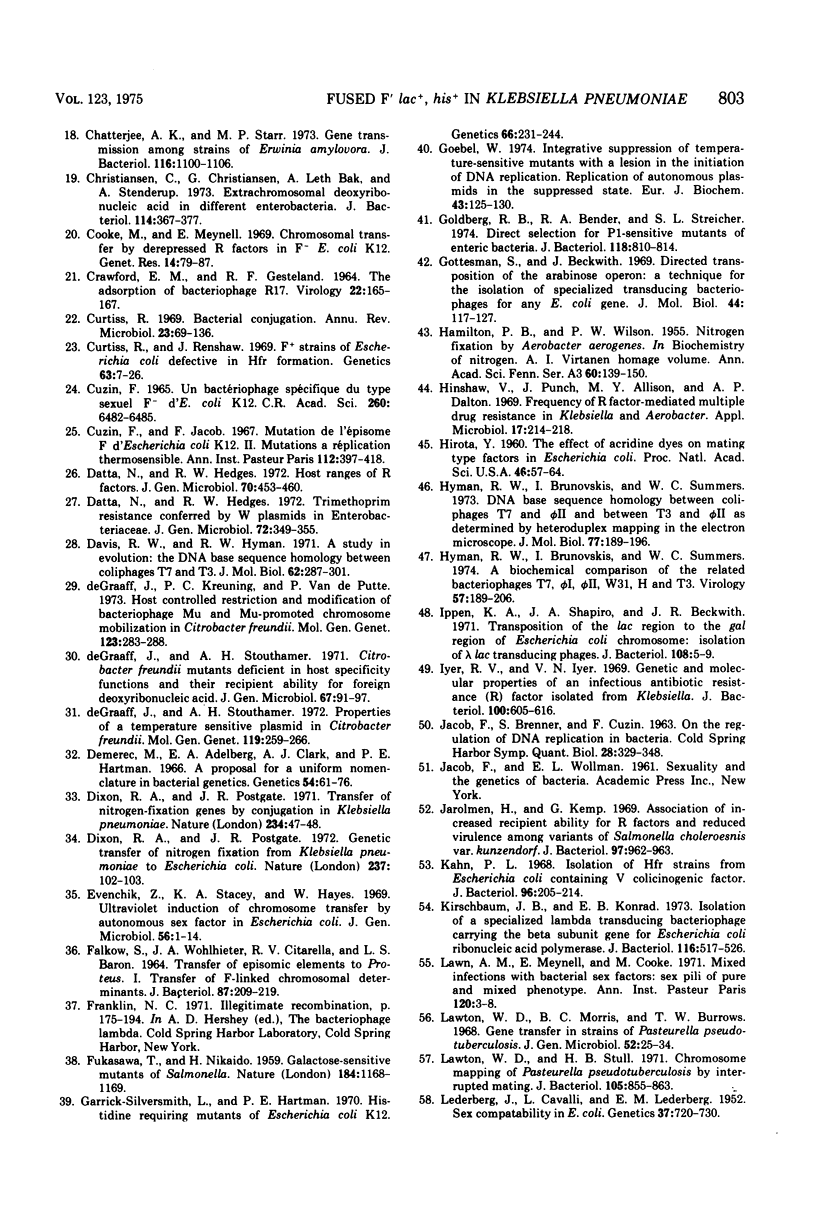
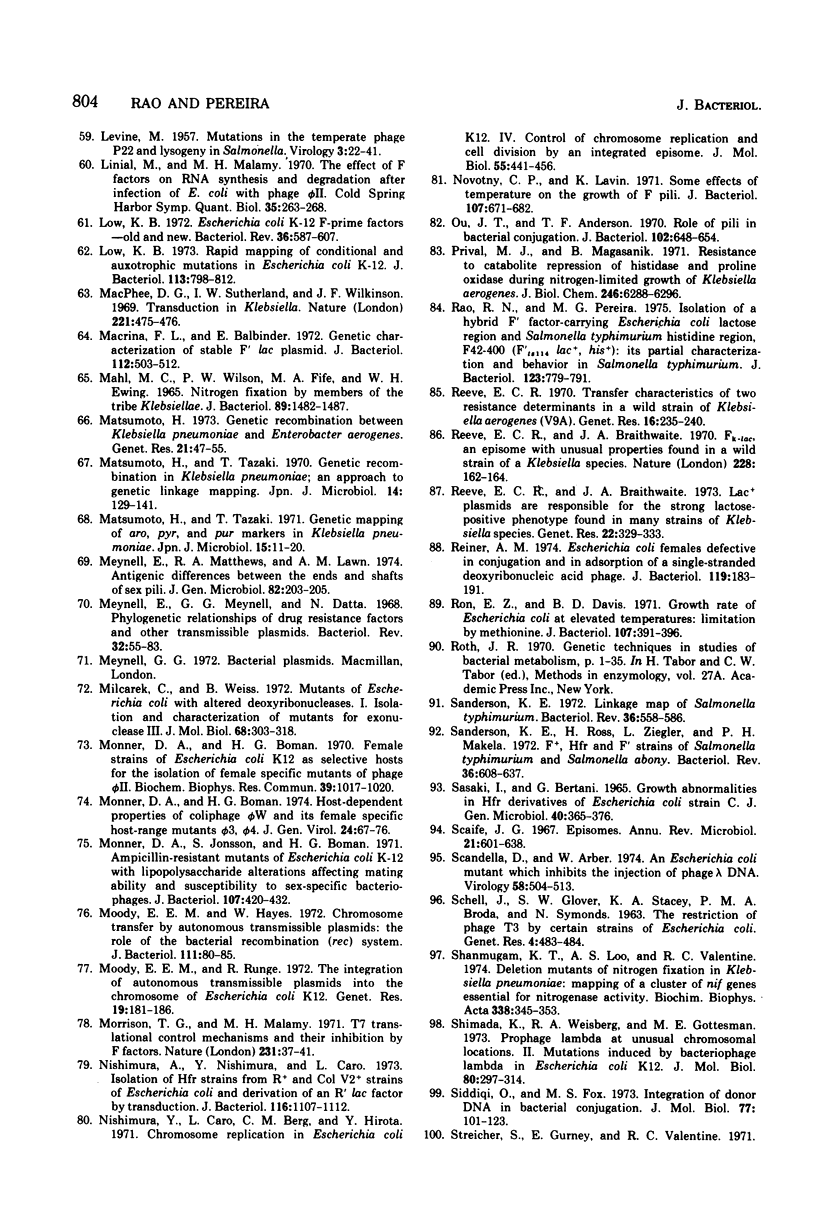

Selected References
These references are in PubMed. This may not be the complete list of references from this article.
- ARBER W., MORSE M. L. HOST SPECIFICITY OF DNA PRODUCED BY ESCHERICHIA COLI. VI. EFFECTS ON BACTERIAL CONJUGATION. Genetics. 1965 Jan;51:137–148. doi: 10.1093/genetics/51.1.137. [DOI] [PMC free article] [PubMed] [Google Scholar]
- Achtman M. Genetics of the F sex factor in enterobacteriaceae. Curr Top Microbiol Immunol. 1973;60:79–123. doi: 10.1007/978-3-642-65502-9_3. [DOI] [PubMed] [Google Scholar]
- Adachi H., Nakano M., Inuzuka M., Tomoeda M. Specific role of sex pili in the effective eliminatory action of sodium dodecyl sulfate on sex and drug resistance factors in Escherichia coli. J Bacteriol. 1972 Mar;109(3):1114–1124. doi: 10.1128/jb.109.3.1114-1124.1972. [DOI] [PMC free article] [PubMed] [Google Scholar]
- Adhya S. L., Shapiro J. A. The galactose operon of E. coli K-12. I. Structural and pleiotropic mutations of the operon. Genetics. 1969 Jun;62(2):231–247. doi: 10.1093/genetics/62.2.231. [DOI] [PMC free article] [PubMed] [Google Scholar]
- Alfaro G., Willetts N. The relationship between the transfer systems of some bacterial plasmids. Genet Res. 1972 Dec;20(3):279–289. doi: 10.1017/s0016672300013811. [DOI] [PubMed] [Google Scholar]
- Appleyard R K. Segregation of Lambda Lysogenicity during Bacterial Recombination in Escherichia Coli K12. Genetics. 1954 Jul;39(4):429–439. doi: 10.1093/genetics/39.4.429. [DOI] [PMC free article] [PubMed] [Google Scholar]
- Arber W. DNA modification and restriction. Prog Nucleic Acid Res Mol Biol. 1974;14(0):1–37. doi: 10.1016/s0079-6603(08)60204-4. [DOI] [PubMed] [Google Scholar]
- Arber W., Linn S. DNA modification and restriction. Annu Rev Biochem. 1969;38:467–500. doi: 10.1146/annurev.bi.38.070169.002343. [DOI] [PubMed] [Google Scholar]
- Beckwith J. R., Signer E. R., Epstein W. Transposition of the Lac region of E. coli. Cold Spring Harb Symp Quant Biol. 1966;31:393–401. doi: 10.1101/sqb.1966.031.01.051. [DOI] [PubMed] [Google Scholar]
- Boman H. G., Eriksson-Grennberg K. G., Normark S., Matsson E. Resistance of Escherichia coli to penicillins. IV. Genetic study of mutants resistant to D,L-ampicillin concentrations o 100 mu-g-ml. Genet Res. 1968 Oct;12(2):169–185. doi: 10.1017/s0016672300011782. [DOI] [PubMed] [Google Scholar]
- Brenchley J. E., Magasanik B. Klebsiella aerogenes strain carrying drug-resistance determinants and a lac plasmid. J Bacteriol. 1972 Oct;112(1):200–205. doi: 10.1128/jb.112.1.200-205.1972. [DOI] [PMC free article] [PubMed] [Google Scholar]
- Brinton C. C., Jr The properties of sex pili, the viral nature of "conjugal" genetic transfer systems, and some possible approaches to the control of bacterial drug resistance. CRC Crit Rev Microbiol. 1971 May;1(1):105–160. doi: 10.3109/10408417109104479. [DOI] [PubMed] [Google Scholar]
- Cannon F. C., Dixon R. A., Postgate J. R., Primrose S. B. Plasmids formed in nitrogen-fixing Escherichia coli-Klebsiella pneumoniae hybrids. J Gen Microbiol. 1974 Jan;80(1):241–251. doi: 10.1099/00221287-80-1-241. [DOI] [PubMed] [Google Scholar]
- Caro L. G., Schnös M. The attachment of the male-specific bacteriophage F1 to sensitive strains of Escherichia coli. Proc Natl Acad Sci U S A. 1966 Jul;56(1):126–132. doi: 10.1073/pnas.56.1.126. [DOI] [PMC free article] [PubMed] [Google Scholar]
- Chatterjee A. K., Starr M. P. Gene transmission among strains of Erwinia amylovora. J Bacteriol. 1973 Dec;116(3):1100–1106. doi: 10.1128/jb.116.3.1100-1106.1973. [DOI] [PMC free article] [PubMed] [Google Scholar]
- Chatterjee A. K., Starr M. P. Genetic transfer of episomic elements among Erwinia species and other enterobacteria: F'Lac+. J Bacteriol. 1972 Jul;111(1):169–176. doi: 10.1128/jb.111.1.169-176.1972. [DOI] [PMC free article] [PubMed] [Google Scholar]
- Christiansen C., Christiansen G., Bak A. L., Stenderup A. Extrachromosomal deoxyribonucleic acid in different enterobacteria. J Bacteriol. 1973 Apr;114(1):367–377. doi: 10.1128/jb.114.1.367-377.1973. [DOI] [PMC free article] [PubMed] [Google Scholar]
- Cooke M., Meynell E. Chromosomal transfer mediated by de-repressed R factors in F- Escherichia coli K12. Genet Res. 1969 Aug;14(1):79–87. doi: 10.1017/s0016672300001877. [DOI] [PubMed] [Google Scholar]
- Curtiss R., 3rd Bacterial conjugation. Annu Rev Microbiol. 1969;23:69–136. doi: 10.1146/annurev.mi.23.100169.000441. [DOI] [PubMed] [Google Scholar]
- Curtiss R., 3rd, Renshaw J. F+ strains of Escherichia coli K-12 defective in Hfr formation. Genetics. 1969 Sep;63(1):7–26. doi: 10.1093/genetics/63.1.7. [DOI] [PMC free article] [PubMed] [Google Scholar]
- Cuzin F., Jacob F. Mutations de l'épisome F d'Escherichia coli K 12. II. Mutants à réplication thermosensible. Ann Inst Pasteur (Paris) 1967 Apr;112(4):397–418. [PubMed] [Google Scholar]
- Cuzin F. Un bactériophage spécifique du type sexuel F- d'Escherichia coli K 12. C R Acad Sci Hebd Seances Acad Sci D. 1965 Jun 14;260(24):6482–6485. [PubMed] [Google Scholar]
- Datta N., Hedges R. W. Host ranges of R factors. J Gen Microbiol. 1972 May;70(3):453–460. doi: 10.1099/00221287-70-3-453. [DOI] [PubMed] [Google Scholar]
- Datta N., Hedges R. W. Trimethoprim resistance conferred by W plasmids in Enterobacteriaceae. J Gen Microbiol. 1972 Sep;72(2):349–355. doi: 10.1099/00221287-72-2-349. [DOI] [PubMed] [Google Scholar]
- Davis R. W., Hyman R. W. A study in evolution: the DNA base sequence homology between coliphages T7 and T3. J Mol Biol. 1971 Dec 14;62(2):287–301. doi: 10.1016/0022-2836(71)90428-1. [DOI] [PubMed] [Google Scholar]
- Demerec M., Adelberg E. A., Clark A. J., Hartman P. E. A proposal for a uniform nomenclature in bacterial genetics. Genetics. 1966 Jul;54(1):61–76. doi: 10.1093/genetics/54.1.61. [DOI] [PMC free article] [PubMed] [Google Scholar]
- Dixon R. A., Postgate J. R. Genetic transfer of nitrogen fixation from Klebsiella pneumoniae to Escherichia coli. Nature. 1972 May 12;237(5350):102–103. doi: 10.1038/237102a0. [DOI] [PubMed] [Google Scholar]
- Dixon R. A., Postgate J. R. Transfer of nitrogen-fixation genes by conjugation in Klebsiella pneumoniae. Nature. 1971 Nov 5;234(5323):47–48. doi: 10.1038/234047a0. [DOI] [PubMed] [Google Scholar]
- Evenchik Z., Stacey K. A., Hayes W. Ultraviolet induction of chromosome transfer by autonomous sex factors in Escherichia coli. J Gen Microbiol. 1969 Apr;56(1):1–14. doi: 10.1099/00221287-56-1-1. [DOI] [PubMed] [Google Scholar]
- FALKOW S., WOHLHIETER J. A., CITARELLA R. V., BARON L. S. TRANSFER OF EPISOMIC ELEMENTS TO PROTEUS. I. TRANSFER OF F-LINKED CHROMOSOMAL DETERMINANTS. J Bacteriol. 1964 Jan;87:209–219. doi: 10.1128/jb.87.1.209-219.1964. [DOI] [PMC free article] [PubMed] [Google Scholar]
- FUKASAWA T., NIKAIDO H. Galactose-sensitive mutants of Salmonella. Nature. 1959 Oct 10;184(Suppl 15):1168–1169. doi: 10.1038/1841168a0. [DOI] [PubMed] [Google Scholar]
- Garrick-Silversmith L., Hartman P. E. Histidine-requiring mutants of Escherichia coli K12. Genetics. 1970 Oct;66(2):231–244. doi: 10.1093/genetics/66.2.231. [DOI] [PMC free article] [PubMed] [Google Scholar]
- Goebel W. Integrative suppression of temperature-sensitive mutants iwth a lesion in the initiation of DNA replication. Replication of autonomous plasmids in the suppressed state. Eur J Biochem. 1974 Mar 15;43(1):125–130. doi: 10.1111/j.1432-1033.1974.tb03392.x. [DOI] [PubMed] [Google Scholar]
- Goldberg R. B., Bender R. A., Streicher S. L. Direct selection for P1-sensitive mutants of enteric bacteria. J Bacteriol. 1974 Jun;118(3):810–814. doi: 10.1128/jb.118.3.810-814.1974. [DOI] [PMC free article] [PubMed] [Google Scholar]
- Gottesman S., Beckwith J. R. Directed transposition of the arabinose operon: a technique for the isolation of specialized transducing bacteriophages for any Escherichia coli gene. J Mol Biol. 1969 Aug 28;44(1):117–127. doi: 10.1016/0022-2836(69)90408-2. [DOI] [PubMed] [Google Scholar]
- Hinshaw V., Punch J., Allison M. J., Dalton H. P. Frequency of R factor-mediated multiple drug resistance in Klebsiella and Aerobacter. Appl Microbiol. 1969 Feb;17(2):214–218. doi: 10.1128/am.17.2.214-218.1969. [DOI] [PMC free article] [PubMed] [Google Scholar]
- Hirota Y. THE EFFECT OF ACRIDINE DYES ON MATING TYPE FACTORS IN ESCHERICHIA COLI. Proc Natl Acad Sci U S A. 1960 Jan;46(1):57–64. doi: 10.1073/pnas.46.1.57. [DOI] [PMC free article] [PubMed] [Google Scholar]
- Hyman R. W., Brunovskis I., Summers W. C. A biochemical comparison of the related bacteriophages T7, phiI, phiII, W31, H, and T3. Virology. 1974 Jan;57(1):189–206. doi: 10.1016/0042-6822(74)90120-2. [DOI] [PubMed] [Google Scholar]
- Hyman R. W., Brunovskis I., Summers W. C. DNA base sequence homology between coliphages T7 and phiII and between T3 and phiII as determined by heteroduplex mapping in the electron microscope. J Mol Biol. 1973 Jun 25;77(2):189–196. doi: 10.1016/0022-2836(73)90330-6. [DOI] [PubMed] [Google Scholar]
- Ippen K., Shapiro J. A., Beckwith J. R. Transposition of the lac region to the gal region of the Escherichia coli chromosome: isolation of lambda-lac transducing bacteriophages. J Bacteriol. 1971 Oct;108(1):5–9. doi: 10.1128/jb.108.1.5-9.1971. [DOI] [PMC free article] [PubMed] [Google Scholar]
- Iyer R. V., Iyer V. N. Genetic and molecular properties of an infectious antibiotic resistance (R) factor isolated from Klebsiella. J Bacteriol. 1969 Nov;100(2):605–616. doi: 10.1128/jb.100.2.605-616.1969. [DOI] [PMC free article] [PubMed] [Google Scholar]
- Jarolmen H., Kemp G. Association of increased recipient ability for R factors and reduced virulence among variants of Salmonella choleraesuis var. kunzendorf. J Bacteriol. 1969 Feb;97(2):962–963. doi: 10.1128/jb.97.2.962-963.1969. [DOI] [PMC free article] [PubMed] [Google Scholar]
- Kahn P. L. Isolation of high-frequency recombining strains from Escherichia coli containing the V colicinogenic factor. J Bacteriol. 1968 Jul;96(1):205–214. doi: 10.1128/jb.96.1.205-214.1968. [DOI] [PMC free article] [PubMed] [Google Scholar]
- Kirschbaum J. B., Konrad E. B. Isolation of a specialized lambda transducing bacteriophage carrying the beta subunit gene for Escherichia coli ribonucleic acid polymerase. J Bacteriol. 1973 Nov;116(2):517–526. doi: 10.1128/jb.116.2.517-526.1973. [DOI] [PMC free article] [PubMed] [Google Scholar]
- LEVINE M. Mutations in the temperate phage P22 and lysogeny in Salmonella. Virology. 1957 Feb;3(1):22–41. doi: 10.1016/0042-6822(57)90021-1. [DOI] [PubMed] [Google Scholar]
- Lawn A. M., Meynell E., Cooke M. Mixed infections with bacterial sex factors: sex pili of pure and mixed phenotype. Ann Inst Pasteur (Paris) 1971 Jan;120(1):3–8. [PubMed] [Google Scholar]
- Lawton W. D., Stull H. B. Chromoome mapping of asteurella pseudotuberculosis by interrupted mating. J Bacteriol. 1971 Mar;105(3):855–863. doi: 10.1128/jb.105.3.855-863.1971. [DOI] [PMC free article] [PubMed] [Google Scholar]
- Lederberg J, Cavalli L L, Lederberg E M. Sex Compatibility in Escherichia Coli. Genetics. 1952 Nov;37(6):720–730. doi: 10.1093/genetics/37.6.720. [DOI] [PMC free article] [PubMed] [Google Scholar]
- Low B. Rapid mapping of conditional and auxotrophic mutations in Escherichia coli K-12. J Bacteriol. 1973 Feb;113(2):798–812. doi: 10.1128/jb.113.2.798-812.1973. [DOI] [PMC free article] [PubMed] [Google Scholar]
- Low K. B. Escherichia coli K-12 F-prime factors, old and new. Bacteriol Rev. 1972 Dec;36(4):587–607. doi: 10.1128/br.36.4.587-607.1972. [DOI] [PMC free article] [PubMed] [Google Scholar]
- MAHL M. C., WILSON P. W., FIFE M. A., EWING W. H. NITROGEN FIXATION BY MEMBERS OF THE TRIBE KLEBSIELLEAE. J Bacteriol. 1965 Jun;89:1482–1487. doi: 10.1128/jb.89.6.1482-1487.1965. [DOI] [PMC free article] [PubMed] [Google Scholar]
- MacPhee D. G., Sutherland I. W., Wilkinson J. F. Transduction in Klebsiella. Nature. 1969 Feb 1;221(5179):475–476. doi: 10.1038/221475a0. [DOI] [PubMed] [Google Scholar]
- Macrina F. L., Balbinder E. Genetic Characterization of a Stable F' lac Plasmid. J Bacteriol. 1972 Oct;112(1):503–512. doi: 10.1128/jb.112.1.503-512.1972. [DOI] [PMC free article] [PubMed] [Google Scholar]
- Matsumoto H., Tazaki T. Genetic mapping of aro, pyr, and pur markers in Klebsiella pneumoniae. Jpn J Microbiol. 1971 Jan;15(1):11–20. [PubMed] [Google Scholar]
- Matsumoto H., Tazaki T. Genetic recombination in Klebsiella pneumoniae. An approach to genetic linkage mapping. Jpn J Microbiol. 1970 Mar;14(2):129–141. doi: 10.1111/j.1348-0421.1970.tb00500.x. [DOI] [PubMed] [Google Scholar]
- Meynell E., Matthews R. A., Lawn A. M. Antigenic differences between the ends and shafts of sex pili. J Gen Microbiol. 1974 May;82(1):203–205. doi: 10.1099/00221287-82-1-203. [DOI] [PubMed] [Google Scholar]
- Meynell E., Meynell G. G., Datta N. Phylogenetic relationships of drug-resistance factors and other transmissible bacterial plasmids. Bacteriol Rev. 1968 Mar;32(1):55–83. doi: 10.1128/br.32.1.55-83.1968. [DOI] [PMC free article] [PubMed] [Google Scholar]
- Milcarek C., Weiss B. Mutants of Escherichia coli with altered deoxyribonucleases. I. Isolation and characterization of mutants for exonuclease 3. J Mol Biol. 1972 Jul 21;68(2):303–318. doi: 10.1016/0022-2836(72)90215-x. [DOI] [PubMed] [Google Scholar]
- Monner D. A., Boman H. G. Female strains of Escherichia coli K12 as selective hosts for the isolation of female specific mutants of phage omega II. Biochem Biophys Res Commun. 1970;39(6):1017–1020. doi: 10.1016/0006-291x(70)90659-5. [DOI] [PubMed] [Google Scholar]
- Monner D. A., Boman H. G. Host-dependent properties of coliphage phiW and its female-specific host-range mutants phi3 and phi4. J Gen Virol. 1974 Jul;24(1):67–75. doi: 10.1099/0022-1317-24-1-67. [DOI] [PubMed] [Google Scholar]
- Monner D. A., Jonsson S., Boman H. G. Ampicillin-resistant mutants of Escherichia coli K-12 with lipopolysaccharide alterations affecting mating ability and susceptibility to sex-specific bacteriophages. J Bacteriol. 1971 Aug;107(2):420–432. doi: 10.1128/jb.107.2.420-432.1971. [DOI] [PMC free article] [PubMed] [Google Scholar]
- Moody E. E., Hayes W. Chromosome transfer by autonomous transmissible plasmids: the role of the bacterial recombination (rec) system. J Bacteriol. 1972 Jul;111(1):80–85. doi: 10.1128/jb.111.1.80-85.1972. [DOI] [PMC free article] [PubMed] [Google Scholar]
- Moody E. E., Runge R. The integration of autonomous transmissible plasmids into the chromosome of Escherichia coli K12. Genet Res. 1972 Apr;19(2):181–186. doi: 10.1017/s0016672300014427. [DOI] [PubMed] [Google Scholar]
- Morrison T. G., Malamy M. H. T7 translational control mechanisms and their inhibiton by F factors. Nat New Biol. 1971 May 12;231(19):37–41. doi: 10.1038/newbio231037a0. [DOI] [PubMed] [Google Scholar]
- Nishimura A., Nishimura Y., Caro L. Isolation of Hfr strains from R+ and ColV2+ strains of Escherichia coli and derivation of an R'lac factor by transduction. J Bacteriol. 1973 Dec;116(3):1107–1112. doi: 10.1128/jb.116.3.1107-1112.1973. [DOI] [PMC free article] [PubMed] [Google Scholar]
- Nishimura Y., Caro L., Berg C. M., Hirota Y. Chromosome replication in Escherichia coli. IV. Control of chromosome replication and cell division by an integrated episome. J Mol Biol. 1971 Feb 14;55(3):441–456. doi: 10.1016/0022-2836(71)90328-7. [DOI] [PubMed] [Google Scholar]
- Novotny C. P., Lavin K. Some effects of temperature on the growth of F pili. J Bacteriol. 1971 Sep;107(3):671–682. doi: 10.1128/jb.107.3.671-682.1971. [DOI] [PMC free article] [PubMed] [Google Scholar]
- Ou J. T., Anderson T. F. Role of pili in bacterial conjugation. J Bacteriol. 1970 Jun;102(3):648–654. doi: 10.1128/jb.102.3.648-654.1970. [DOI] [PMC free article] [PubMed] [Google Scholar]
- Prival M. J., Magasanik B. Resistance to catabolite repression of histidase and proline oxidase during nitrogen-limited growth of Klebsiella aerogenes. J Biol Chem. 1971 Oct 25;246(20):6288–6296. [PubMed] [Google Scholar]
- Rao R. N., Pereira M. G. Isolation of a hybrid F' factor-carrying Escherichia coli lactose region and Salmonella typhimurium histidine region, F42-400 (F' ts114 lac+, his+): its partial characterization and behavior in Salmonella typhimurium. J Bacteriol. 1975 Sep;123(3):779–791. doi: 10.1128/jb.123.3.779-791.1975. [DOI] [PMC free article] [PubMed] [Google Scholar]
- Reeve E. C., Braithwaite J. A. Fk-lac, an episome with unusual properties found in a wild strain of a Klebsiella species. Nature. 1970 Oct 10;228(5267):162–164. doi: 10.1038/228162a0. [DOI] [PubMed] [Google Scholar]
- Reeve E. C., Braithwaite J. A. Lac-plus plasmids are responsible for the strong lactose-positive phenotype found in many strains of Klebsiella species. Genet Res. 1973 Dec;22(3):329–333. doi: 10.1017/s0016672300013124. [DOI] [PubMed] [Google Scholar]
- Reeve E. C. Transfer characteristics of two resistance determinants in a wild strain of Klebsiella aerogenes (V9A). Genet Res. 1970 Oct 2;16(2):235–240. doi: 10.1017/s0016672300002470. [DOI] [PubMed] [Google Scholar]
- Reiner A. M. Escherichia coli females defective in conjugation and in adsorption of a single-stranded deoxyribonucleic acid phage. J Bacteriol. 1974 Jul;119(1):183–191. doi: 10.1128/jb.119.1.183-191.1974. [DOI] [PMC free article] [PubMed] [Google Scholar]
- Ron E. Z., Davis B. D. Growth rate of Escherichia coli at elevated temperatures: limitation by methionine. J Bacteriol. 1971 Aug;107(2):391–396. doi: 10.1128/jb.107.2.391-396.1971. [DOI] [PMC free article] [PubMed] [Google Scholar]
- Sanderson K. E. Linkage map of Salmonella typhimurium, edition IV. Bacteriol Rev. 1972 Dec;36(4):558–586. doi: 10.1128/br.36.4.558-586.1972. [DOI] [PMC free article] [PubMed] [Google Scholar]
- Sanderson K. E., Ross H., Ziegler L., Mäkelä P. H. F + , Hfr, and F' strains of Salmonella typhimurium and Salmonella abony. Bacteriol Rev. 1972 Dec;36(4):608–637. doi: 10.1128/br.36.4.608-637.1972. [DOI] [PMC free article] [PubMed] [Google Scholar]
- Sasaki I., Bertani G. Growth abnormalities in Hfr derivatives of Escherichia coli strain C. J Gen Microbiol. 1965 Sep;40(3):365–376. doi: 10.1099/00221287-40-3-365. [DOI] [PubMed] [Google Scholar]
- Scaife J. Episomes. Annu Rev Microbiol. 1967;21:601–638. doi: 10.1146/annurev.mi.21.100167.003125. [DOI] [PubMed] [Google Scholar]
- Scandella D., Arber W. An Escherichia coli mutant which inhibits the injection of phage lambda DNA. Virology. 1974 Apr;58(2):504–513. doi: 10.1016/0042-6822(74)90084-1. [DOI] [PubMed] [Google Scholar]
- Shimada K., Weisberg R. A., Gottesman M. E. Prophage lambda at unusual chromosomal locations. II. Mutations induced by bacteriophage lambda in Escherichia coli K12. J Mol Biol. 1973 Oct 25;80(2):297–314. doi: 10.1016/0022-2836(73)90174-5. [DOI] [PubMed] [Google Scholar]
- Siddiqi O., Fox M. S. Integration of donor DNA in bacterial conjugation. J Mol Biol. 1973 Jun 15;77(1):101–123. doi: 10.1016/0022-2836(73)90365-3. [DOI] [PubMed] [Google Scholar]
- Streicher S. L., Gurney E. G., Valentine R. C. The nitrogen fixation genes. Nature. 1972 Oct 27;239(5374):495–499. doi: 10.1038/239495a0. [DOI] [PubMed] [Google Scholar]
- Streicher S., Gurney E., Valentine R. C. Transduction of the nitrogen-fixation genes in Klebsiella pneumoniae. Proc Natl Acad Sci U S A. 1971 Jun;68(6):1174–1177. doi: 10.1073/pnas.68.6.1174. [DOI] [PMC free article] [PubMed] [Google Scholar]
- Susskind M. M., Wright A., Botstein D. Superinfection exclusion by P22 prophage in lysogens of Salmonella typhimurium. II. Genetic evidence for two exclusion systems. Virology. 1971 Sep;45(3):638–652. doi: 10.1016/0042-6822(71)90178-4. [DOI] [PubMed] [Google Scholar]
- Taylor A. L., Trotter C. D. Linkage map of Escherichia coli strain K-12. Bacteriol Rev. 1972 Dec;36(4):504–524. doi: 10.1128/br.36.4.504-524.1972. [DOI] [PMC free article] [PubMed] [Google Scholar]
- Toussaint A., Faelen M. Connecting two unrelated DNA sequences with a Mu dimer. Nat New Biol. 1973 Mar 7;242(114):1–4. doi: 10.1038/newbio242001a0. [DOI] [PubMed] [Google Scholar]
- VOGEL H. J., BONNER D. M. Acetylornithinase of Escherichia coli: partial purification and some properties. J Biol Chem. 1956 Jan;218(1):97–106. [PubMed] [Google Scholar]
- Voll M. J. Derivation of an F-merogenote and a phi-80 high-frequency transducing phage carrying the histidine operon os Salmonella. J Bacteriol. 1972 Feb;109(2):741–750. doi: 10.1128/jb.109.2.741-750.1972. [DOI] [PMC free article] [PubMed] [Google Scholar]
- WATANABE T., OKADA M. NEW TYPE OF SEX FACTOR-SPECIFIC BACTERIOPHAGE OF ESCHERICHIA COLI. J Bacteriol. 1964 Mar;87:727–736. doi: 10.1128/jb.87.3.727-736.1964. [DOI] [PMC free article] [PubMed] [Google Scholar]
- Watanabe T., Arai T., Hattori T. Effects of cell wall polysaccharide on the mating ability of Salmonella typhimurium. Nature. 1970 Jan 3;225(5227):70–71. doi: 10.1038/225070a0. [DOI] [PubMed] [Google Scholar]
- Wiedemann B., Schmidt G. The problems of drug-resistant pathogenic bacteria. Experimental and clinical aspects of resistance determinants. Structure and recipient ability in E. Coli mutants. Ann N Y Acad Sci. 1971 Jun 11;182:123–125. doi: 10.1111/j.1749-6632.1971.tb30651.x. [DOI] [PubMed] [Google Scholar]
- Willetts N., Maule J. Surface exclusion by ColV-K94. Genet Res. 1973 Jun;21(3):297–299. doi: 10.1017/s0016672300013495. [DOI] [PubMed] [Google Scholar]
- Willetts N. The genetics of transmissible plasmids. Annu Rev Genet. 1972;6:257–268. doi: 10.1146/annurev.ge.06.120172.001353. [DOI] [PubMed] [Google Scholar]
- Williams L., Meynell G. G. Female-specific phages and F-minus strains of Escherichia coli K12. Mol Gen Genet. 1971;113(3):222–227. doi: 10.1007/BF00339542. [DOI] [PubMed] [Google Scholar]
- Wiman M., Bertani G., Kelly B., Sasaki I. Genetic map of Escherichia coli strain C. Mol Gen Genet. 1970;107(1):1–31. doi: 10.1007/BF00433220. [DOI] [PubMed] [Google Scholar]
- Wood T. H. Effects of temperature, agitation, and donor strain on chromosome transfer in Escherichia coli K-12. J Bacteriol. 1968 Dec;96(6):2077–2084. doi: 10.1128/jb.96.6.2077-2084.1968. [DOI] [PMC free article] [PubMed] [Google Scholar]
- Yarmolinsky M. B., Wiesmeyer H., Kalckar H. M., Jordan E. HEREDITARY DEFECTS IN GALACTOSE METABOLISM IN ESCHERICHIA COLI MUTANTS, II. GALACTOSE-INDUCED SENSITIVITY. Proc Natl Acad Sci U S A. 1959 Dec;45(12):1786–1791. doi: 10.1073/pnas.45.12.1786. [DOI] [PMC free article] [PubMed] [Google Scholar]
- Yoshikawa M. Identification and mapping of the replication genes of an R factor, R100-1, integrated into the chromosome of Escherichia coli K-12. J Bacteriol. 1974 Jun;118(3):1123–1131. doi: 10.1128/jb.118.3.1123-1131.1974. [DOI] [PMC free article] [PubMed] [Google Scholar]
- de Graaff J., Kreuning P. C., van de Putte P. Host controlled restriction and modification of bacteriophage Mu and Mu-promoted chromosome mobilization in Citrobacter freundii. Mol Gen Genet. 1973 Jul 2;123(3):283–288. doi: 10.1007/BF00271245. [DOI] [PubMed] [Google Scholar]
- de Graaff J., Stouthamer A. H. Citrobacter freundii mutants deficient in host specificity functions and their recipient ability for foreign deoxyribonucleic acid. J Gen Microbiol. 1971 Jul;67(1):91–97. doi: 10.1099/00221287-67-1-91. [DOI] [PubMed] [Google Scholar]
- de Graaff J., Stouthamer A. H. Properties of a temperature sensitive plasmid in Citrobacter freundii. Mol Gen Genet. 1972;119(3):259–266. doi: 10.1007/BF00333863. [DOI] [PubMed] [Google Scholar]
- van de Putte P., Gruijthuijsen M. Chromosome mobilization and integration of F-factors in the chromosome of RecA strains of E. coli under the influence of bacteriophage Mu-1. Mol Gen Genet. 1972;118(2):173–183. doi: 10.1007/BF00267086. [DOI] [PubMed] [Google Scholar]


